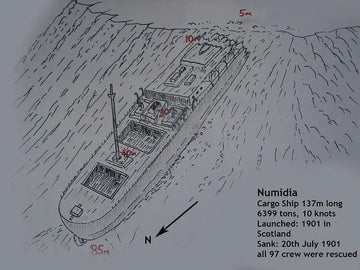The Numidia was a British freighter, built in Glasgow in 1901, which had a weight of 6,400 tons and 140 feet long, able to sail up to 10 knots. It was a high-class vessel for the time intended for long journeys... like its the last one.
Before we proceed, did you know that we design t-shirts for divers, including diving t-shirts in the Red Sea? They are top-quality and perfect for your diving buddy :-)
On July 6th 1901 left Liverpool direction Calcutta loaded with 7,000 tons of materials, including railways, small wagons, several steam engines and 97 crew members. Two weeks after its departure from the port the Numidia sailed the Red Sea when collided at high speed with the north side of Big Brother island one of the two islands of Brothers Islands.
 The Numidia, heading Calcutta
The Numidia, heading Calcutta
After the accident the captain ordered the crew, seeing the seriousness of the crash, to abandon the ship. During the two months following the accident the removal work was carried out the load while importance of the situation was getting worse and the water got inside the ship... and started falling slowly to the bottom of the reef. The bow broke and fell on the reef slope and eventually the rest of the front section started spreading up the hillside.
______________________
The best liveaboard offers in the Red Sea
______________________
Diving the Numidia wreck
The ship lies today in a very steep slope in the northern part of the plateau of Big Brother Island, to a minimum depth of 10 meters and a maximum of 85. The keel is stuck deep in a rocky projection, preventing it from sliding to the bottom of the reef despite its strong currents... the same ones that bring food to corals, gray sharks and pelagic creatures like hammerhead sharks among others.
The intact hull offers a perfect protection from currents to reef fish and the starboard side is, after more than a century under the Red Sea, decorated with beautiful soft corals to the point that the portholes are hardly identificable. Along the corridors of the bridge you can see lionfish in large numbers and down to the front cover can dive to the holds, which mark the limit of recreational diving. Gorgeous clouds of orange and yellow anthias, snappers and carangidae swirl in company of barracudas and reef sharks.
Around 40 meters deep you'll find the entrance to the engine room that provides spectacular light effects with the machinery in good condition: you can see the engine's cylinders, pressure gauges or entrance doors. This area is home to many glass fish that as in other wrecks of the Red Sea have occupy the room to the delight of underwater photographers who create beautiful scenes with banks of hundreds of these small fish. Most wood floors are gone and allow both a better light input as an easier access to dive inside.
The coral encrusted only have a rival in the Red Sea, the Aida, very close, and perhaps the Umbria wreck, further south, in Sudan. As we ascend and finishing the dive you admire, at 10 meters deep beams scattered throughout the reef and a few remains of railway wagon, a great opportunity for scenery photography.





















